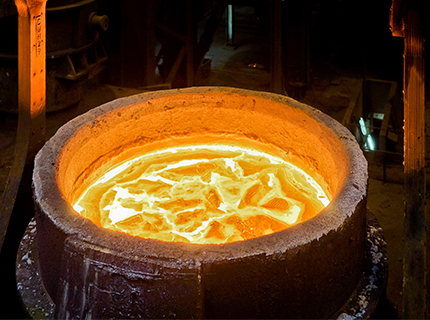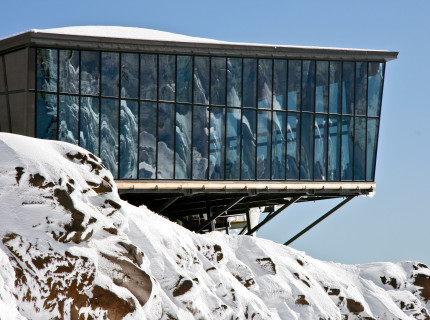The Origin of Scale
During slab reheating and hot rolling, oxides form on the surface of the steel. During hot rolling there are three forms of rolled in scale that are not normally removed during pickling.
| Primary or Furnace Scale: This scale forms on the slab in the reheat furnace by reaction between the surface of the steel with combustion gasses that include excess air, water vapour and carbon dioxide. Extended time in reheat furnaces due to delays contribute to abnormally thick scale layers that are not easily removed by the high pressure water sprays prior to the Roughing Mill. Primary scale is not continuous but can be well dispersed along the strip surface. It is normally deep rooted and extremely difficult to completely remove by pickling (will be left with deep pits as a minimum). |
| Secondary Scale: This defect classification is intended to cover scale remaining as a result of ineffective scale removal at the rougher and the high pressure water sprays prior to the Finishing Mill. Often called jet scale. |
| Tertiary or Fleck Scale: This scale is a result of work roll deterioration (breakdown of the oxide layer on the roll) in the finishing stands (normally stands 1 or 2) of the Hot Strip Mill. Breakdown of the work rolls is usually progressive and results in a continuous scale pattern on the strip surface. The effect is like sprinkling pepper over the strip surface. It may show up in bands or cover the whole surface depending on the condition of the work roll. |
The normal scale we see that is a blue/grey in colour and covers the entire strip surface is generated in the last stands of the Finishing Mill, across the run-out table and during cooling of the coil. This type of scale is removed during pickling. This scale forms when the iron in the steel reacts with oxygen in the air. The thickness and chemical composition of the scale (its morphology) is influenced by the hot strip temperature, around 860°C exit the finishing mill and around 650°C upon coiling, and the amount of oxygen available at the strip surface while the strip is hot.
The characteristic pattern that we see on the edges of the hot rolled strip is due to the availability of oxygen. When the strip is coiled up, air can only penetrate a small distance into the coil and the scale type and thickness will be different between the edges and the middle of the strip (dark bands). This also explains why the head and tail ends appear darker than the remainder of the coil.
Steel coiled at higher temperatures has a thicker scale layer (750°C » 12 microns whereas 570°C » 6 microns) and the composition of the scale is largely influenced by the cooling rate after coiling. The faster the cooling the higher the proportion of wüstite. The scale on steel comprises three oxides of iron that differ in the proportions of oxygen:
| % Iron (Fe) | % Oxygen (O) | |
| Fe2O3 (hematite) | 69.9 | 30.1 |
| Fe3O4 (magnetite) | 72.4 | 27.6 |
| FeO (wüstite) | 77.7 | 22.3 |
Hematite, the highest in oxygen, is the outermost oxide in the scale layer when present (pinkish tinge), and wüstite, lowest in oxygen, is the innermost oxide. At temperatures above 566°C wüstite is transformed to iron and magnetite. wüstite is formed first and is then reduced successively by the iron to form magnetite and then to the hematite. The final result being a scale composed of layers richest in oxygen at the scale surface and richest in iron at the metal surface. Wüstite, the layer next to the metal surface constitutes about 85% of the scale thickness, the magnetite 10 to 15% and the hematite 0.5 to 2%.
Scale must be removed from the strip surface prior to cold rolling. This is achieved through mechanical (scale breaking) and chemical (pickling) processes. If not removed the scale will have the following detrimental effects.
- In the cold rolling-annealing circuit scale produces a dirty surface or allows rust to reform.
- During galvanising scale can cause poor to total adhesion failure, especially if the strip is to be coated with ZINCALUME®.
- Scale not only makes the product unsightly but is prone to accelerated corrosion.
- Severe scale patches can also affect the cold rolling process, reduction will be affected with the possibility of the rolls skidding on the rougher sections causing mill wrecks.
The Pickling Process
The pickling process may be broken into two sections: mechanical scale breaking and chemical pickling.
Scale Breaking
Scale breaking is the term used when the surface of the strip is flexed and stretched so that the scale is cracked. This scale cracking assists in the pickling process as it allows the hydrochloric acid to penetrate to the substructure (richer in iron) dissolving the scale (iron oxide) from the strip surface.
As the strip passes through the line it will pass around large and small rolls which will crack the scale as the strip is flexed. The tension leveller is the final area where the scale is flexed prior to pickling. In this process the steel strip is extended but because of the brittleness of the scale it tends to crack and break away from the steel base. Scale dust should be removed via a suction or vacuum system. It has been shown that effective tension levelling will improve the pickling efficiency by around 20%. Primary, secondary and tertiary scale will not be affected by scale breaking.
The scale that has formed on the surface of the strip is equivalent to approximately 0.45% of the total weight of the coil, or 4.5 tonne of scale per 1000 tonne of raw coil.
Pickling
The pickling process is carried out in three deep bath tanks with acid concentration (strength) being the strongest in the tank 3 and the weakest in tank 1. Tank 1 is designed to be the weakest as it is here, where the strip first enters the bath, that the steel is at room temperature and acts as a large heat sink thus reducing the effectiveness of the pickling reaction.
The reaction between the hydrochloric acid and the scale is complex but the end result is that the scale is almost completely removed in the acid.
With HCl (Hydrochloric acid) the reactions with scale are:
Other symbols are: Fe (iron), H2O (water), H2 (hydrogen)
| (hematite) | Fe2O3 | + | Fe | + | 6HC1 | ------ | 3FeCl2 | + | 3H2O |
| (magnetite) | Fe3O4 | + | Fe | + | 8HC1 | ------ | 4FeCl2 | + | 4H2O |
| (wústite) | FeO | + | + | 2HCl | ------ | FeCl2 | + | H2O |
Reaction with HCl and base steel is: Fe + 2HCl---- FeCl2 + H2 If no inhibitor is used to limit the attack of the acid on the base metal during slow running or a line stop, excessive weight loss may occur as well as a roughened surface and a reduction in the strip's average thickness. Strip lifters are provided to remove the strip from the acid solution during extended delays.
The reaction involving the scale (iron oxide) and hydrochloric acid proceeds more quickly if pure iron (Fe) is in contact with the acid. Cracks made in the scale layer during the scale breaking stage allow the iron in the steel strip to come into contact with the acid and pickling becomes easier.
Other factors that assist in the effectiveness of the pickling process are, the solution temperature and the acid concentration and in both cases the higher they are the faster the pickling can take place. There are of course limits to the temperature and acid concentrations that can be used, but before the actual limits are reached it becomes uneconomical to run higher because the acid breaks down with the generation of hydrogen chloride vapour.
The fastest way to govern the effectiveness of the pickling process is to adjust the speed, as this determines the length of time the material will spend in the tanks. To make an effective change by increasing temperature or concentration will result in a time lag and continued defective product.
The following diagram shows the effect of temperature and acid concentration on descaling time (which can be converted to speed) for low carbon hot rolled strip pickled in hydrochloric acid.
Advantages of using hydrochloric acid (over sulphuric acid):
- Faster pickling rates
- Brighter pickled surface
- Well proven, efficient regeneration methods
- A lower volume of spent pickle liquor, especially if indirect heating is used rather than steam sparging
- More complete reaction of acid during pickling
- Availability of effective inhibitors that do not interfere with the pickling process
Rinsing
Following the pickling of the strip, the strip will have residue of acid solution on the surface. The residue needs to be removed prior to cold rolling, and this is carried out in the dip and rinse spray tanks. The strip then passes through a set of squeegee rolls and a hot air drier. The pH is measured and controlled in these tanks for two basic reasons:
- Reduce the activeness of the surface so that it will slow down the reformation of oxides (rust)
- Prevent a low or high pH solution being carried into the mill as this will wash off into the coolant and adversely affecting its lubrication properties



